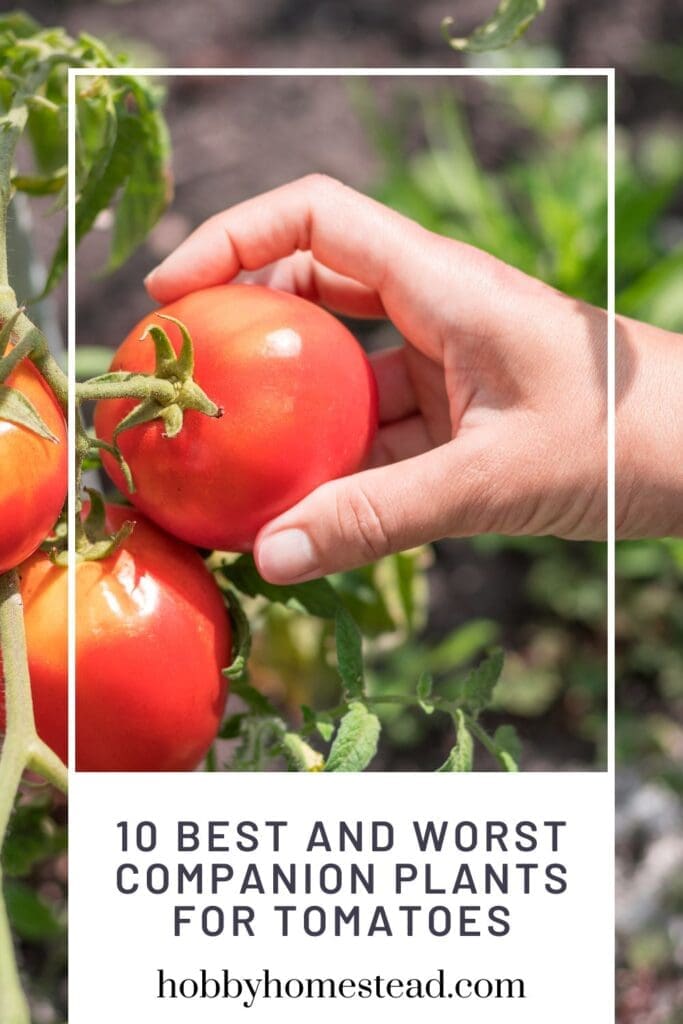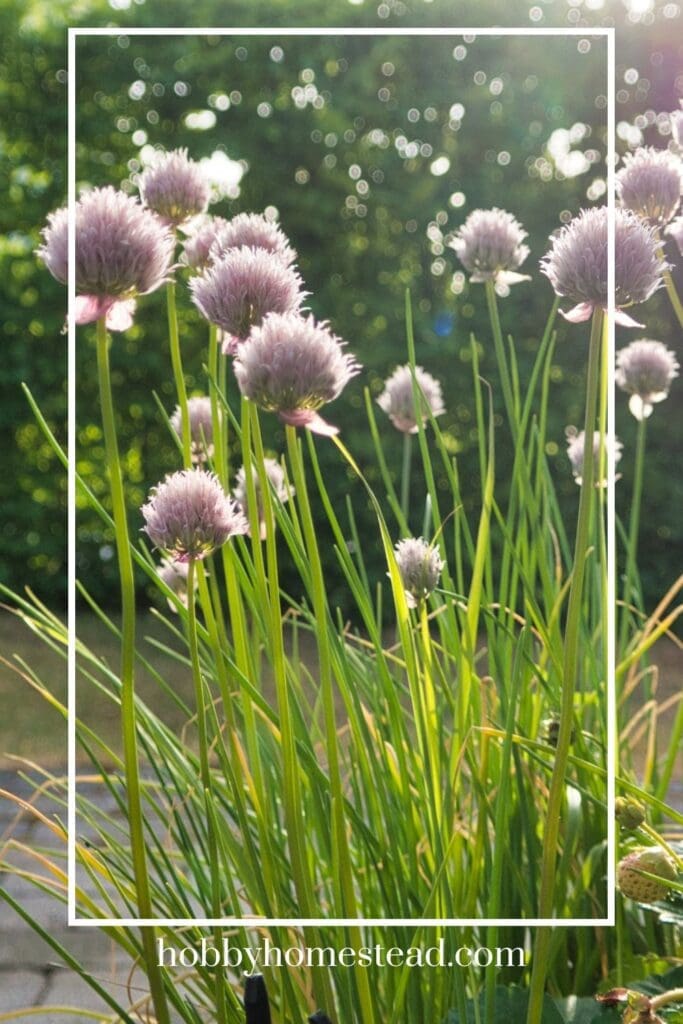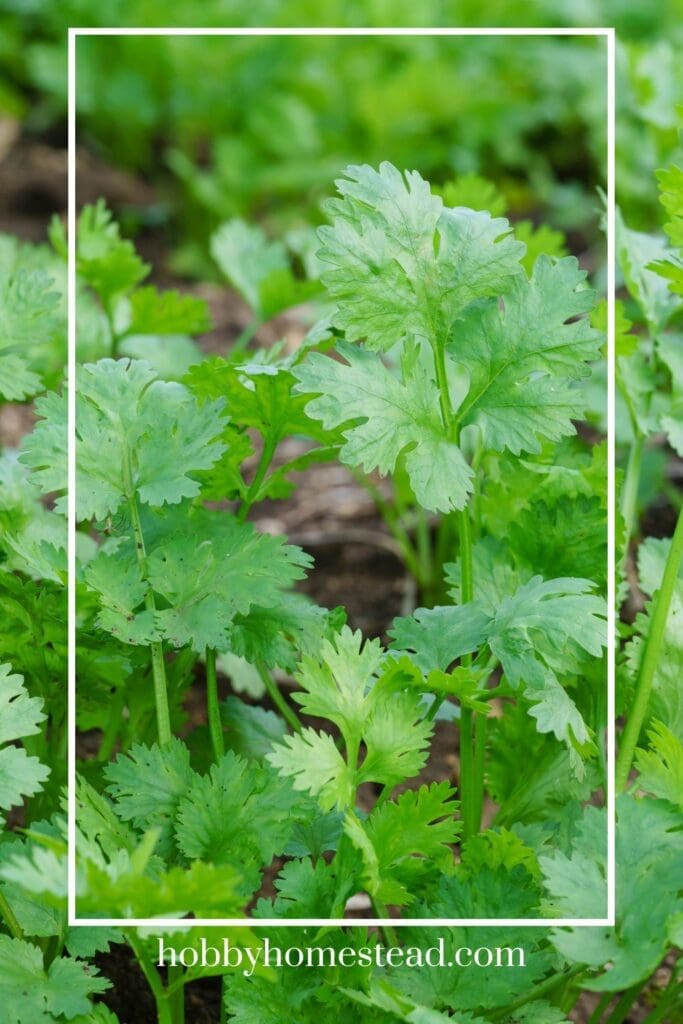Last updated on April 25th, 2025 at 09:58 am
When planning the layout of your garden, consider companion plants for tomatoes. It helps maximize the growing space and discourage pests from invading your growing plants
Companion planting is a tried-and-true gardening technique that helps boost crop production, deter pests, and improve soil health. Choosing the right companion plants can enhance tomato growth, while planting the wrong ones can hinder development, attract pests, or spread disease.
In this guide, we’ll explore the 10 best companion plants for tomatoes and 10 plants to avoid, along with expert tips for a more productive garden.

What Are Companion Plants?
Companion planting is the practice of growing certain plants together to create a mutually beneficial relationship. The benefits of companion planting include:
- Attracting beneficial insects like bumble bees and parasitic wasps
- Repelling pest insects such as tomato hornworms and flea beetles
- Improving soil fertility by adding organic matter and nitrogen
- Reducing the risk of fungal diseases by enhancing air circulation
- Acting as trap crops to lure pests away from tomato plants
By selecting the right companion plants, you can grow healthier, more productive tomatoes while minimizing pest pressure and disease.
Table of contents
The Benefits of Companion Planting
Companion planting offers a variety of benefits for tomatoes, from repelling pests and improving soil health to attracting beneficial insects. However, before selecting companion plants, ensure they thrive in the same conditions as tomatoes—full sun and rich, well-drained soil.
Strongly scented herbs can help deter insect pests, while flowering plants attract pollinators. Although tomatoes are self-fertile and can produce fruit without pollinators, they tend to yield larger harvests when bees and other beneficial insects are present.
Low-growing herbs act like living mulch, helping to retain moisture and suppress weeds, making them ideal for container gardening with tomatoes. Root crops naturally aerate the soil, promoting healthier tomato root development, while certain plants repel small pests. Some ornamentals even attract predatory insects that feed on common tomato pests.
Key Benefits of Companion Planting with Tomatoes
- Maximizes garden space efficiency
- Improves soil structure and fertility
- Provides natural pest and disease control
- Acts as living mulch for sustainable weed suppression
- Attracts pollinators for increased yields
- Enhances the overall health and growth of nearby plants
- Offers a secondary edible harvest
Some companion plants, known as trap crops, may be sacrificed to protect tomatoes from pests. However, many companion plants provide mutual benefits and can be harvested alongside your tomatoes. The key is to identify what your tomato plants need most and experiment with different combinations to find what works best in your garden.
10 Best Companion Plants for Tomatoes
1. Basil
A great companion plant for tomatoes, basil enhances the flavor of tomatoes and repels insect pests like tomato hornworms, aphids, and whiteflies. Its strong scent also deters mosquitoes and houseflies.
2. French Marigolds
Marigolds are known for their ability to repel root-knot nematodes, which attack tomato roots. Their essential oils deter pest insects, and they attract beneficial bugs like parasitic wasps and ladybugs.
3. Bush Beans
Bush beans are nitrogen fixers, enriching the rich soil tomatoes need. They act as a living mulch, preventing soil erosion and keeping tomato beds moist. Pole beans, however, should be avoided (more on that later).
4. Sweet Alyssum
This edible flower is a good companion because it attracts good bugs like hoverflies, which feed on aphids. It also serves as a ground cover, reducing weed competition and conserving moisture.
5. Onions & Garlic (Onion Family)
The onion family repels spider mites, flea beetles, and carrot flies. Their strong scent also masks the aroma of tomatoes, making it harder for pests to find them.
6. Carrots
Carrots are a good neighbor in small-space gardens. Their different root systems help aerate the soil, promoting healthy plant growth without competing for nutrients.
7. Lettuce & Spinach
These smaller plants make great companions because they grow well in the shade of tomato plants, keeping the soil cool and moist while reducing the spread of fungal diseases.
8. Nasturtiums
This trap crop lures aphids and whiteflies away from tomatoes. It also repels tomato pests like flea beetles and acts as a good ground cover.
9. Chives
A good companion plant, chives help deter aphids and cabbage worms. They also improve the flavor of tomatoes and add essential nutrients to the soil.
10. Celery
Celery is a good choice because it repels pest insects while benefiting from the shade of tomato plants, leading to a mutually beneficial relationship.

Best Tomato Companion Plants to Repel Harmful Insects
Protecting your tomato plants from pest insects is essential for a productive garden. By selecting the right companion plants, you can naturally reduce pest pressure and support healthy tomato growth without relying on chemical pesticides.
Below are some of the best tomato companion plants that effectively repel harmful insects while providing additional benefits.
1. French Marigolds – The Ultimate Pest Fighter
Why it Works. French marigolds release essential oils that repel aphids, whiteflies, root-knot nematodes, and spider mites. Their strong scent also confuses flea beetles, reducing damage to your tomato crop.
Bonus Benefit. Serves as a trap crop, drawing pests away from tomatoes.
2. Calendula (Pot Marigolds) – Natural Pest Control
Why it Works. Calendula helps repel aphids, whiteflies, and nematodes while attracting beneficial insects like parasitic wasps and hoverflies, which prey on tomato pests.
Bonus Benefit. Works as a living mulch, improving soil fertility and weed control.
3. Chives – A Fragrant Insect Deterrent
Why it Works. The strong scent of chives repels aphids, flea beetles, and Japanese beetles, making them a great tomato companion plant.
Bonus Benefit. Chives improve the flavor of tomatoes when grown nearby.
4. Black-Eyed Peas – A Natural Trap Crop
Why it Works. These good companion plants attract aphids and leafhoppers, keeping them away from your tomato patch.
Bonus Benefit. They also fix nitrogen in the soil, improving soil fertility for tomato beds.
5. Radishes – An Aphid and Flea Beetle Repellent
Why it Works. Radishes serve as a trap crop, drawing aphids and flea beetles away from tomato plants.
Bonus Benefit. Helps aerate the soil, promoting healthy tomato root development.
6. Sage – A Strong-Scented Defense
Why it Works. Sage’s essential oils repel flea beetles, cabbage worms, and tomato hornworms, keeping them away from your tomato crop.
Bonus Benefit. Attracts bumble bees and other pollinators, increasing tomato yields.
7. Nasturtiums – A Beautiful Trap Crop
Why it Works. Nasturtiums attract aphids, flea beetles, and whiteflies, keeping them off your tomatoes. Their peppery leaves also deter some pests.
Bonus Benefit. Edible flowers add a spicy kick to salads and sandwiches.

Best Tomato Companion Plants to Attract Beneficial Insects
Encouraging beneficial insects in your vegetable garden helps keep pest populations under control while supporting tomato growth.
These beneficial companion plants attract good bugs like parasitic wasps, bumble bees, and ladybugs, which help fight off tomato pests such as aphids, spider mites, and tomato hornworms.
1. Cilantro – A Magnet for Parasitic Wasps
Why it Works. Cilantro’s delicate flowers attract parasitic wasps, which feed on caterpillar pests like tomato hornworms.
Bonus Benefit. Also attracts hoverflies, which eat aphids.
2. Oregano – A Fragrant Haven for Pollinators
Why it Works. The tiny blooms of oregano draw in bumble bees, lacewings, and hoverflies, helping keep pest pressure down.
Bonus Benefit. Its strong scent confuses insect pests, making it a great tomato companion plant.
3. Parsley – A Host Plant for Swallowtail Butterflies
Why it Works. Parsley attracts predatory wasps and serves as a host plant for swallowtail butterfly caterpillars, which don’t harm tomato plants.
Bonus Benefit. Works well in small space gardens and containers.
Best Tomato Companion Plants for Weed Control
Companion planting can also help suppress weeds, reducing the need for constant maintenance. These plants act as living mulch, improving soil fertility while limiting unwanted competition.
1. Crimson Clover – A Cover Crop for Rich Soil
Why it Works. Crimson clover acts as a ground cover, preventing weeds from taking over your tomato patch. It also fixes nitrogen in the soil, feeding heavy feeders like tomatoes.
Bonus Benefit. Helps prevent soil erosion and adds organic matter when tilled into the soil.

Best Tomato Companion Plants to Increase Pollination
Although tomatoes are self-fertile, they produce greater yields when pollinators like bumble bees and butterflies are around. These flowering companion plants help boost tomato crop production.
1. Lavender – A Pollinator Paradise
Why it Works. The strong scent of lavender attracts bumble bees and honeybees, increasing pollination rates.
Bonus Benefit. Repels flea beetles and cabbage worms while adding a delightful fragrance to your garden.
2. Sunflowers – A Beacon for Bees
Why it Works. Sunflowers attract good bugs like bees, lacewings, and predatory beetles, helping with pollination and pest control.
Bonus Benefit. Their tall stalks provide shade for smaller plants that don’t tolerate intense heat.
3. Zinnias – A Butterfly Magnet
Why it Works. Zinnias attract butterflies and hoverflies, which help pollinate tomatoes and reduce aphid populations.
Bonus Benefit. Their vibrant colors add beauty to your garden bed.
Best Plants to Grow in Containers with Tomatoes
If you’re growing tomatoes in small spaces, like patio containers or raised beds, these good companion plants can maximize crop production while offering pest control and air circulation benefits.
1. Sweet Alyssum – A Compact Living Mulch
Why it Works. Sweet alyssum serves as a living mulch, reducing weeds while attracting beneficial insects that prey on aphids.
Bonus Benefit. Its delicate white flowers complement cherry tomatoes beautifully.
2. Thyme – A Pest-Repelling Herb
Why it Works. Thyme’s strong scent repels tomato pests like whiteflies and flea beetles, making it a great tomato companion plant.
Bonus Benefit. A perennial herb, it thrives in containers year after year.

10 Worst Companion Plants for Tomatoes
1. Cabbage & Brussels Sprouts (Brassica Family)
The brassica family competes with tomatoes for nutrients and attracts cabbage worms, which can spread to tomatoes. They also reduce air circulation, increasing the risk of powdery mildew.
2. Corn
Corn and tomatoes attract similar pests, such as tomato hornworms and corn earworms, leading to increased pest pressure.
3. Dill (Mature Plants)
While young dill plants are good neighbors, mature dill can stunt tomato growth by releasing chemicals that inhibit plant development.
4. Fennel
Fennel is a host plant for many pest insects, and its roots release compounds that inhibit tomato growth.
5. Walnut Tree
Walnut trees release juglone, a toxin that inhibits tomato crop production and leads to stunted growth. Avoid planting tomatoes near walnut trees.
6. Eggplant & Peppers (Nightshade Family)
Tomatoes, eggplants, and peppers belong to the same plant family and are all susceptible to the same fungal diseases and pest damage, including root-knot nematodes.
7. Potatoes
Like eggplants and peppers, potatoes are part of the nightshade family and attract tomato pests like flea beetles and spider mites. They also compete for the lot of nutrients tomatoes need.
8. Pole Beans
Unlike bush beans, pole beans can interfere with air circulation around tomato plants, leading to higher risks of fungal diseases.
9. Sweet Potatoes
Sweet potatoes have aggressive different root systems that compete with tomato roots for nutrients and space, potentially leading to stunted growth.
10. Rosemary & Other Woody Herbs
Perennial herbs like rosemary are not good neighbors for tomatoes because they prefer dry, sandy soil, whereas tomatoes need rich soil and regular watering.
Final Tips for Companion Planting Success
Rotate crops each growing season to prevent soil depletion and pest populations from building up.
Keep good neighbors in close proximity while maintaining proper air circulation to reduce fungal diseases.
Plant cover crops in early spring to improve soil fertility before planting tomatoes.
Use organic matter like compost to maintain healthy plants and support productive tomatoes.
By planting the best tomato companion plants, you can naturally repel harmful insects, improve soil health, and create a more productive garden.
Companion planting is a good choice for those looking to use organic pest control methods while promoting a mutually beneficial relationship between different plants.
With these best tomato companion plants, you can grow healthy, delicious tomatoes while avoiding the worst plant pairings.
References
Martha Stewart. The Best Companion Plants for Tomatoes, Plus Tips to Make Sure Yours Thrive.
The Spruce. 21 Best (and 7 Worst) Companion Plants for Tomatoes.


